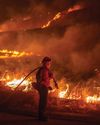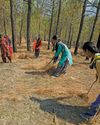
FROM AN early onset of heatwaves across northern states to one of the worst floods in recent years in Assam and other northeastern states, India has experienced several record-breaking weather events so far this year. Though frightening, the year is by no means abnormal. "Since the middle of the twentieth century, India has witnessed...a rise in extreme temperature and rainfall events, droughts, and sea levels; and an increase in the intensity of severe cyclones, alongside other changes in the monsoon system," reads an assessment by the Union Ministry of Earth Sciences in June 2020.
If this is India's situation when the Earth is 1.1°C hotter than in the pre-industrial period, then imagine the scenario when the global temperature rises by 1.5oC. According to the UN Intergovernmental Panel on Climate Change’s (IPCC) Assessment Report 6 of Working Group I, the world is on track to breach this temperature guardrail in the next 18 years.
Down To Earth (DTE) has pieced together the latest information released by IPCC in 2021 to understand how the temperature and rainfall patterns in Indian states and Union Territories (UTS) will change in a 1.5°C warmer world. The findings are alarming. It underscores the need to get serious about the climate crisis and at the same time gives insights into what awaits each state or UT. This will help the governments in climate adaptability.
India could become 1.2°C warmer and receive almost 10 per cent more rainfall every year, suggests the analysis by DTE. Ladakh is likely to be the worst hit at 2.23°C warmer than pre-industrial levels. Annual temperatures mean may rise in five other Himalayan states-Jammu and Kashmir Himachal (1.76°C), Pradesh (1.73°C), Uttarakhand (1.62°C), Sikkim (1.55°C) and Arunachal Pradesh (1.47°C). The temperature rise is most likely to trigger the rapid melting of glaciers and precipitation change.
This story is from the {{IssueName}} edition of {{MagazineName}}.
Start your 7-day Magzter GOLD free trial to access thousands of curated premium stories, and 9,000+ magazines and newspapers.
Already a subscriber ? Sign In
This story is from the {{IssueName}} edition of {{MagazineName}}.
Start your 7-day Magzter GOLD free trial to access thousands of curated premium stories, and 9,000+ magazines and newspapers.
Already a subscriber? Sign In

THE CIRCULARITY ARGUMENT
A circular economy can help India achieve its developmental aspirations while following the low-carbon pathway. It will also help address the challenges of waste management, pollution and overexploitation of natural resources. Industries are already innovating to reuse high-volume wastes and have shown that the transition can usher in both environmental and financial windfalls

Banking on flawed drug voluntary licences
The Medicines Patent Pool is pushing for more VLs, but its bad deal with Novartis on a cancer drug shows the pitfalls

Lasting solutions
For the first time, the UN has recognised the role of indigenous communities in tackling aridity. A repository of traditional knowledge India has the wherewithal to lead the way

IMD at 150
India's journey into modern weather forecasting took a decisive turn 150 years ago with the establishment of India Meteorological Department during the British rule. The agency has come a long way since then, shaping the way the country predicts and responds to its diverse climate challenges

Every drop counts
In drought-prone Marathwada region, 14 villages have managed to counter water shortage by budgeting the resource

Threat to survival
Hollongapar Gibbon Sanctuary in Assam faces ecological challenges as railway electrification and hydrocarbon exploration endanger its fragile biodiversity

'Migration is going to be a battlefield'
AMITAV GHOSH is one of the foremost chroniclers of our times. His literary sojourn includes writings on topics that range from languages to climate change to human lives. His latest book, Wild Fictions, brings some of his works on these issues under one title. In a conversation with RAJAT GHAI, Ghosh shares his views on the future of human movement. Excerpts:

Face of future
California wildfires confirm forest fires are intensifying in a hotter world, emitting substantial amounts of greenhouse gases and reinforcing global warming

Friends of the forest
Residents of 30 villages in Uttarakhand establish a model for public participation in saving forests from wildfires

Climate-crazy playbook
Just hours after his second (and final) term began on January 20, US President Donald Trump unleashed 46 presidential actions. Several of these are centred on the US' climate commitments, energy transition, migration and trade policies, and are likely to have negative global implications